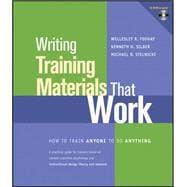
Dr. Ken Silber is associate professor of instructional design at Northern Illinois University in DeKalb, Illinois. He is a performance consulting/ID/change management professional with 30 years of experience in consulting in corporate, nonprofit, and academic settings both in the U.S. and internationally.
Dr. Michael B. Stelnicki is Professor and Chairman of the graduate Human performance and training program at Governors State University in University Park, Illinois. He is a thirty-five year veteran presenter in the field and has worked as a journalist, psychology instructor, instructional television producer/director and consultant to business and industry.
List of Figures.
Contents of the CD-ROM.
Acknowledgments.
Preface.
Introduction.
PART I: INTRODUCTION TO THE COGNITIVE APPROACH.
Chapter 1: The Cognitive Approach to Training Development.
The Cognitive Approach to Instructional Design.
The Cognitive Point of View on How Learning Occurs.
Declarative and Procedural Knowledge and Their Subtypes.
Summary.
Chapter 2: A Cognitive Training Model.
A New Cognitive Model.
Learner Tasks and Lesson Elements.
How to Read the Cognitive Training Model.
Differentiating Our Model from Gagne's.
How to Use the Model.
Summary.
PART II: HOW TO DESIGN LESSONS USING THE COGNITIVE APPROACH.
Chapter 3: How to Begin Any Lesson: The First Three Lesson Elements.
About Using the Lesson Elements Attention, WIIFM, and YCDI to Begin a Lesson.
Using the Lesson Elements Attention, WIIFM, and YCDI to Begin a Lesson.
Summary.
Chapter 4: How to Organize and Present Information: Message Design Principles.
About Using the Lesson Elements to Help Learners Organize the Information.
Summary.
Chapter 5: Teaching Facts.
About Facts.
General Strategies for Teaching Facts.
Using the Lesson Elements to Teach Facts.
Summary.
Chapter 6: Teaching Concepts.
About Concepts.
General Strategies for Teaching Concepts.
Using the Lesson Elements to Teach Concepts.
Summary.
Chapter 7: Teaching Principles and Mental Models.
About Principles and Mental Models.
General Strategies for Teaching Principles and Mental Models.
Using the Lesson Elements to Teach Principles and Mental Models.
Summary.
Chapter 8: Teaching Well-Structured Problem-Solving.
About Well-Structured Problem-Solving.
General Strategies for Teaching Well-Structured Problem-Solving.
Using the Lesson Elements to Teach Well-Structured Problem-Solving.
Summary.
Chapter 9: Teaching Ill-Structured Problem-Solving.
About Ill-Structured Problem-Solving.
Problems Learning Ill-Structured Problem-Solving.
General Strategies for Teaching Ill-Structured Problem-Solving.
Using the Lesson Elements to Teach Ill-Structured Problem-Solving.
Summary.
Chapter 10: Teaching Troubleshooting.
About Troubleshooting.
General Strategies for Teaching Troubleshooting.
Using the Lesson Elements to Teach Troubleshooting.
Summary.
Chapter 11: Teaching Complete Lessons.
Combining Declarative and Procedural Teaching: Two Approaches.
Two Key ID Issues.
Template.
An Example of the Recommended Approach to Combined Lessons.
Summary.
PART III: USING THE COGNITIVE APPROACH: THE RESEARCH ISSUES.
Chapter 12: Issues Underlying the Cognitive Approach to Instructional Design.
Purpose and Approach.
How the Behavioral and Cognitive Approaches Differ.
Summary.
Chapter 13: Issues Underlying Teaching Declarative Knowledge.
How Declarative and Procedural Knowledge Differ.
Facts.
Concepts.
Principles and Mental Models.
Common Errors in Teaching Declarative Knowledge.
Summary.
Chapter 14: Issues Underlying Teaching Procedural Knowledge.
About Procedural Knowledge.
Terminology.
How Learners Solve Problems.
Problem-Solving Strategies.
Teaching Procedural Knowledge to Solve Problems.
Issues in Teaching Ill-Structured Problem Solving.
Issues in Teaching Troubleshooting.
Summary.
Further Reading.
About the Authors.
Index.
How to Use the CD-ROM.
The New copy of this book will include any supplemental materials advertised. Please check the title of the book to determine if it should include any access cards, study guides, lab manuals, CDs, etc.
The Used, Rental and eBook copies of this book are not guaranteed to include any supplemental materials. Typically, only the book itself is included. This is true even if the title states it includes any access cards, study guides, lab manuals, CDs, etc.